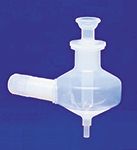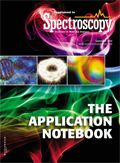Savillex PFA Cyclonic Spray Chamber for ICP-OES and ICP-MS
Application Notebook
The new Savillex PFA Cyclonic Spray Chamber is the first inert chamber with the traditional shape of a glass cyclonic, and is also the first translucent inert chamber.
The new Savillex PFA Cyclonic Spray Chamber is the first inert chamber with the traditional shape of a glass cyclonic, and is also the first translucent inert chamber. Combining excellent stability with high sensitivity, the Savillex PFA offers performance similar to that of a good glass cyclonic.
The Savillex PFA Cyclonic Spray Chamber (CSC) for ICP-OES and ICP-MS is manufactured using Savillex's unique stretch blow molding technology. Unlike other inert cyclonics, which are manufactured from individual machined parts that are assembled or welded together, stretch blow molding allows the Savillex PFA CSC to be molded in an optimum cyclonic shape similar to the traditional shape of a glass or quartz cyclonic. Its translucent walls allow the user to see inside the chamber during operation, while the very smooth surface finish helps improve washout. A deep spoiler is molded into the side walls, improving signal stability and preventing re-nebulization, and a drain guide on the baffle tip promotes smooth draining. The CSC is manufactured independently of the exit port and baffle, so that the same chamber can be used with and without a baffle, and even used on different instruments simply by changing the exit port/connector. The nebulizer port accepts any 6 mm OD nebulizer, although the port is optimized for the Savillex C-Flow PFA concentric: simply insert the C-Flow fully and tighten the port nut: nebulizer insertion depth is automatically optimized. The Savillex PFA CSC has excellent stability and sensitivity, and is also available with an optional surface treatment, which further enhances sensitivity.

Figure 1: Savillex spray chamber.
Performance Comparison – ICP-MS
The performance of both versions of the Savillex PFA CSC (treated and untreated) was compared to a PFA cyclonic from another manufacturer ("PFA Cyclonic A"), using ICP-MS. The table above shows stability and sensitivity across the mass range, Ce2+ and CeO levels. Both versions of the Savillex PFA CSC demonstrated superior signal stability and sensitivity, and the Savillex treated version was 60% more sensitive than PFA Cyclonic A. For more information, go to www.savillex.com/cyclonic.

Table I: 10 min stability test; nebulizer used: Savillex C400d PFA concentric, pumped at 350 µL/min; 10 ppb multielement tune solution
Savillex Corporation
10321 West 70th St., Eden Prairie, MN 55344
tel. (952) 935-4100
Website: www.savillex.com

Thermo Fisher Scientists Highlight the Latest Advances in Process Monitoring with Raman Spectroscopy
April 1st 2025In this exclusive Spectroscopy interview, John Richmond and Tom Dearing of Thermo Fisher Scientific discuss the company’s Raman technology and the latest trends for process monitoring across various applications.
A Seamless Trace Elemental Analysis Prescription for Quality Pharmaceuticals
March 31st 2025Quality assurance and quality control (QA/QC) are essential in pharmaceutical manufacturing to ensure compliance with standards like United States Pharmacopoeia <232> and ICH Q3D, as well as FDA regulations. Reliable and user-friendly testing solutions help QA/QC labs deliver precise trace elemental analyses while meeting throughput demands and data security requirements.